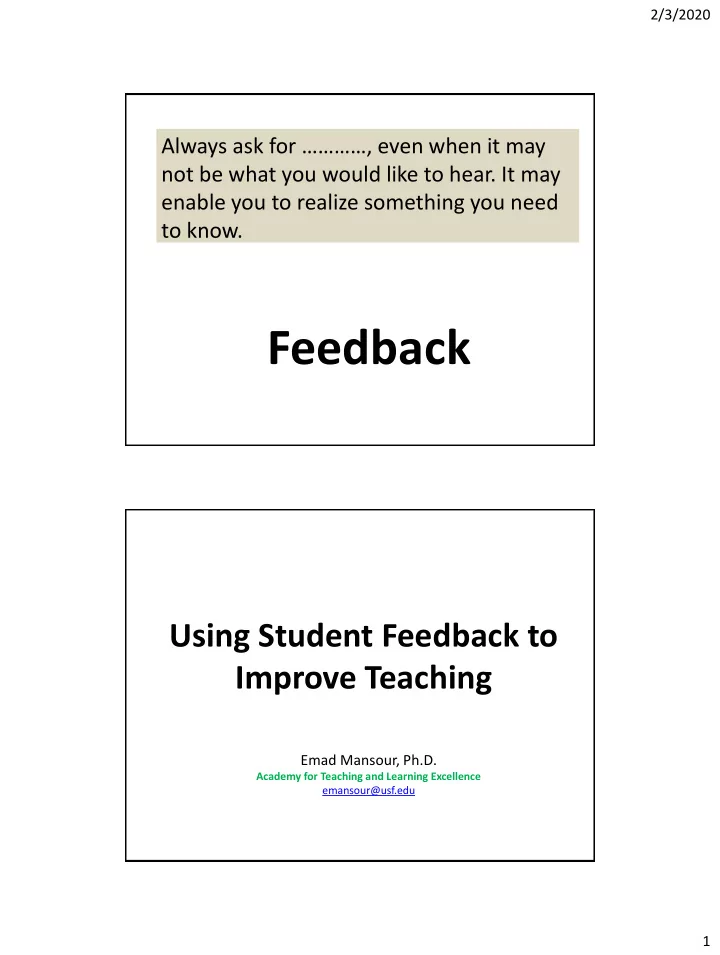

2/3/2020 Always ask for …………, even when it may not be what you would like to hear. It may enable you to realize something you need to know. Feedback Using Student Feedback to Improve Teaching Emad Mansour, Ph.D. Academy for Teaching and Learning Excellence emansour@usf.edu 1
2/3/2020 Objectives By the end of this presentation, participants will be able to: • Identify different sources for student feedback • Identify tools and practices for using student feedback to improve teaching Where can we look for feedback? 2
2/3/2020 Brookfield’s Four Lenses for Reflective Teaching • Autobiography (Reflective portfolio, Philosophy, Narrative, Video-record) • Theory (literature) • Colleague’s perceptions (Peer Review) • Student’s eyes Steven Brookfield, 1995 Sources? • Classroom informal assessment (CATs) (ongoing) • Reflective feedback (ongoing) • Mid-semester feedback (half-way) • End-of semester evaluation (at the end) • ? 3
2/3/2020 Sources • Classroom informal assessment (CATs) • Reflective feedback • Mid-semester feedback (half-way) • End-of semester evaluation (at the end) Classroom Assessment Techniques CATs Brief, non-credit, effective, direct, formative classroom activities, used before, during, and after learning process, to assess and improve student learning, to clarify and improve your teaching. 4
2/3/2020 Examples • Focused listing • One sentence summary • Think, pair, share • Questions and answer pairs / shuffled questions • Concept maps • Approximate analogy • Background • Empty Outline knowledge probe (BKP) • Clickers • One minute paper • Directed paraphrasing • The muddiest point • Quote -1 Handout- short list CATS Brief Classroom that are Formative Activities that provide Non-credit done when feedback about student learning Before, during, after teaching Focused Listing Which include to BKP Clarify & Improve Teaching to Concept maps Improve Student Learning 5
2/3/2020 Sources • Classroom informal assessment (CATs) • Reflective feedback • Mid-semester feedback (half-way) • End-of semester evaluation (at the end) Learning Audit “A three-item response sheet administered after a class asking students: 1) What do you know that you didn’t know this time last week? 2) What can you do that you couldn’t do this time last week? 3) What could you teach someone else to know or do that you couldn’t have taught them this time last week ?” Brookfield, 2012 6
2/3/2020 Critical Incident Questionnaire • Final 5 min. of last class of week • Summary provided at start of the first class the following week – Common themes Benefits: • Clarifies confusions and ambiguities early before they are disasters • Encourages students to be reflective learners • Builds trust in teachers • Provides possibilities for our development Handout- CIQ Activity Exit Interview • What are the most important new skills that you gained from taking this course? • How your ideas about X changed after taking this course • What was the least significant topic (s)? • What helped you learn? • What hindered your learning? • What advice you would give to future students? • What question remains unanswered? 7
2/3/2020 Sources • Classroom informal assessment (CATs) • Reflective feedback • Mid-semester feedback (half-way) • End-of semester evaluation (at the end) Mid-Semester Feedback Group Instructional Feedback Technique (GIFT) Informal Early Feedback (IEF) Interim Course Feedback System (ICF) Keep Doing, Quit Doing, Start Doing (KQS) Midterm Student Feedback (MSF) Mid-Semester Student Feedback (MSF) Online Mid-semester Feedback Quick Course Diagnosis (QCD) Small Group Instructional Diagnosis (SGID) Small all Grou oup Ins nstr tructio ional al Fe Feedback (SG SGIF) Student Feedback through Consensus (SFC) Teaching Analysis by Students (TABS) 8
2/3/2020 What is SGIF? • A Confidential formative evaluation in which voluntary and anonymous student perspectives about the course and the teaching are gathered in class at mid-term by a consultant in absence of the instructor. • The instructor is provided with a summary of student responses with additional comments on how to improve teaching at same semester. The SGIF Process 3 basic questions. Students write down the thoughts of their groups. – What is going well so far in this class? – What suggestions do you have for improvement? – Additional comments? 9
2/3/2020 Alternatives • Online Surveys – Canvas anonymous survey (under Quizzes) – Qualtrics survey Sources • Classroom informal assessment (CATs) • Reflective feedback • Mid-semester feedback (half-way) • End-of semester evaluation (at the end) 10
2/3/2020 End of Semester Evaluation • Description of Course Objectives and Assignments • Communication of Ideas and Information • Expression of Expectations for Performance • Availability to Assist Students In or Out of Class • Respect and Concern for Students • Stimulation of Interest in the Course • Facilitation of Learning • Overall Rating of the Instructor • Please provide any additional comments with respect to – " Instructor Name ." – " Course Title ." Improving Student Response Rate To prevent only stronger opinion responders: • Climate (friendly and respectful) • Talk about the value of SET in class • Remind students/personal emails • Midterm evaluation (+ Xplorance questions) • Provide a 10 min. period during the evaluation window (14 d). • Ask for screen shot confirming completion • Extra credit or bonus points? • Drop a low assignment grade (if >80%) 11
2/3/2020 Summary • Classroom informal assessment (CATs) • Reflective feedback (CIQ- Learning Audit- Exit interview) • Mid-semester feedback (SGIF- Online- After hour group) • End-of semester evaluation (talk about it- friendly environment- interpret wisely) 12
2/3/2020 • From: S.D. Brookfield Becoming a Critically Reflective Teacher . San Francisco: Jossey-Bass, 1995. 13
Recommend
More recommend